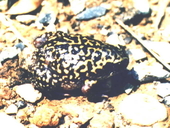|
Uperodon systoma (Schneider, 1799)
Marbled Balloon Frog | family: Microhylidae subfamily: Microhylinae genus: Uperodon |
 © 2008 Rafaqat Masroor (1 of 15) |
|
|
|
Description Color: Dorsum with more or less symmetrical dark brown pattern on a pinkish brown background. Ventrum whitish. Distribution and Habitat Country distribution from AmphibiaWeb's database: Bangladesh, India, Nepal, Pakistan, Sri Lanka
Abdulali (1962) reported large numbers of this frog in Khanapur, Mysore, southern India, in the month of May. This species is widely distributed in southern and eastern India, extending into northern Sri Lanka (Kirtisinghe 1957). Common in southern India. Life History, Abundance, Activity, and Special Behaviors While it is burrowing. the loosened soil is thrown sideways by its powerful hind legs and the animal sinks into the cavity so formed, with the eyes the last to disappear underground. Moist soil is essential for this frog. During dry months the frog retreats into the moist environs of termite nests, termites being its main food item (Mukerji 1931). Mukerji (1931) collected a specimen of this species from a depth of 1-1.5 m. It had lived for 13 months without food. The body of the frog is globular due to the enormously developed inflated lungs. The breeding season extends from May to July, during monsoon rains (Ferguson 1904). The males call from the banks of torrents or paddy fields. The call is like a bleating goat, and during calling the subgular vocal sac is distended so enormously it looks like a float. The eggs are laid in masses which float on the surface of the water (Ferguson 1904; Annandale and Rao 1918). Larva Possible reasons for amphibian decline General habitat alteration and loss Comments
References
Abdulali, H. (1962). ''An account of a trip to the Barapede Cave, Talewandi, Belgaum District, Mysore State, with some notes on reptiles and amphibians.'' Journal of Bombay Natural History Society, 59, 228-237. Bole-Gowda, B.N. (1948). The Spermatogenesis of Uperodon systoma. Unpublished dissertation, Mysore University, Mysore. Gvozdik, L. and Radek, H. (1997). ''A small collection of amphibians from Baluchistan and Punjab, Pakistan in the Silesian Museum.'' Časopis Slezského Muzea Opava, Série A, 46, 203-208. Kirtisinghe, P. (1957). The Amphibia of Ceylon. Self-published, Colombo, Sri Lanka. Mukerji, D.D. (1931). ''Some observations on the burrowing toad Cacopus globulosum Günther.'' Journal and Proceedings of the Asiatic Society of Bengal, 27, 97-100. Rao, C.R.N. (1918). ''Notes on the tadpoles of Indian Engystomatidae.'' Records of the Indian Museum, 15, 41-45. Originally submitted by: M. S. Khan (first posted 2002-03-19) Description by: Michelle S. Koo (updated 2021-05-09)
Distribution by: Michelle S. Koo (updated 2021-05-09)
Life history by: Michelle S. Koo (updated 2021-05-09)
Comments by: Michelle S. Koo (updated 2021-05-09)
Edited by: Vance T. Vredenburg, Joyce Gross, Michelle S. Koo (2022-08-15) Species Account Citation: AmphibiaWeb 2022 Uperodon systoma: Marbled Balloon Frog <https://amphibiaweb.org/species/2223> University of California, Berkeley, CA, USA. Accessed May 9, 2025.
Feedback or comments about this page.
Citation: AmphibiaWeb. 2025. <https://amphibiaweb.org> University of California, Berkeley, CA, USA. Accessed 9 May 2025. AmphibiaWeb's policy on data use. |



 Map of Life
Map of Life